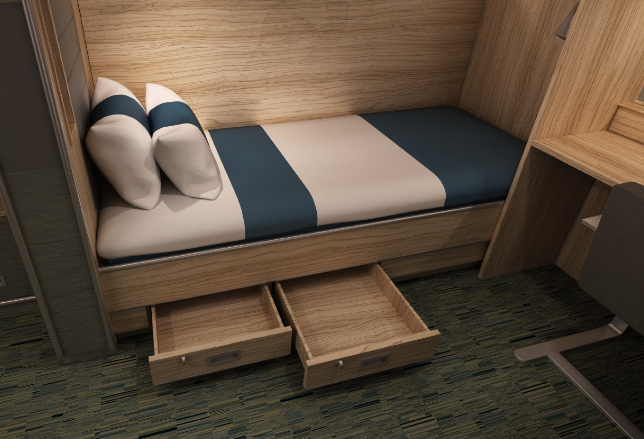
Bilfinger’s innovative cabin solutions aid operators in maximising POB.
Across the UKCS, bed space offshore is increasingly in demand. With a lack of offshore accommodation options, operators face costly alternatives to get the correct employees on-site, including additional helicopters, flotels and walk to work vessels.
Aberdeen-based Bilfinger Salamis UK has developed a number of innovative “plus one” pulldown bed solutions which tie in with recent Health and Safety Executive (HSE) guidelines to increase bed space in existing offshore accommodation modules.
The company has over 25 years’ experience in architectural outfitting for the offshore sector, including design, construction, maintenance and bespoke solutions.
Technical development engineer Jinda Nelson explains the accommodation challenges faced on many ageing assets.
“When some of the North Sea’s assets were commissioned over 30 years ago, offshore living quarters were often designed to accommodate several persons on board (POB) into one cabin, with overcrowding – or ‘hot bunking’ – and communal showers considered the norm,” she said.
“Over time, guidelines were reissued to improve the comfort and wellbeing of those working offshore, and cabin occupation was minimised to two people per cabin.
“The impact of this is now felt when operators struggle to secure bed space for workers during shutdown periods, project works and drilling operations.”
With the energy industry under pressure to find more cost-effective solutions for getting personnel on-site, the HSE has released updated accommodation guidelines for offshore installations, with the aim of assisting operators to maximise POB, while maintaining the welfare and comfort of the offshore workforce.
The guidance specifies that a third person can now be permitted into a cabin in a 24-hour period, on the basis that no more than two will occupy a room at any given time and that each person must have their own bunk. This effectively means that two dayshift workers can share a room with another employee working nightshift.
Assets that have had a recent lifeboat capacity increase could also be permitted to increase their POB through modifications to their existing cabins.
Jinda said this allows operators to make better use of their accommodation modules, creating additional bed space in the existing cabin footprint.
“The new guidance means an asset could increase its POB by up to 50% without moving outwith the original footprint of the existing living quarters,” she said. “Obviously careful consideration is required when surveying and designing these three-man cabins to ensure the best use of space while still considering the wellbeing of the offshore worker.
“At Bilfinger, our architectural department can deliver Pulman-style beds, which fold down from the wall and rest on top of the existing bed, and can then be packed away when the employee is back on shift.
“We also offer swivel beds which simply rotate to offer two sleeping surfaces.
“Both of these options allow separate beds and mattresses, complying with the new guidelines and making excellent use of existing cabins.
“Our engineers also have the experience to guide operators on the impact of increasing the POB on muster areas, sickbays, laundry and food areas, ensuring facilities are set up to manage the additional personnel onboard.”
